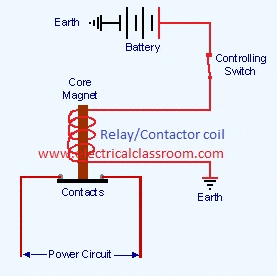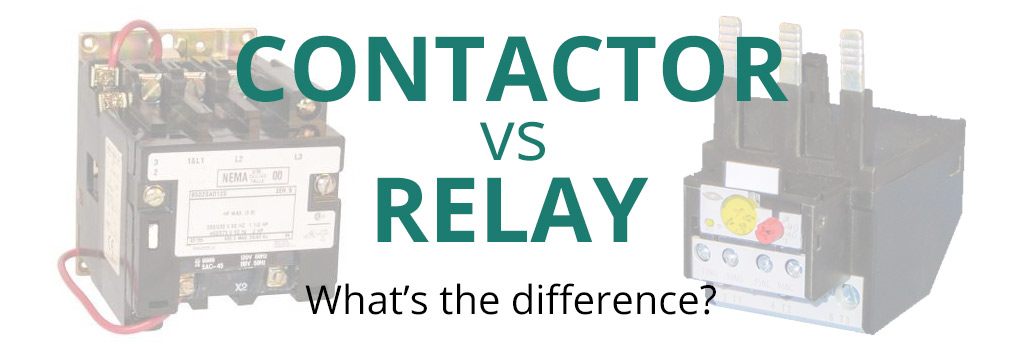A contactor is an electrically controlled switch used for switching an electrical power circuit similar to a relay except with higher current ratings. Change the position of the contacts one way.

The Key Difference Between Contactor And Relay Simpified
We need at least 10 more requests to produce the solution.

. In both components the magnetic field from the coil opens or closes the contacts. A contactor is controlled by a circuit which has a much lower power level than the switched circuit. Explain the application of contactors and relays in control systems Correctly install a contactor or relay in a control system Draw a simple schematic wiring diagram using contactors andor relays to control load in a control system.
They have specially designed arc chutes to mitigate the electric arcs formed during the switching of high current loads. Though their output is used for switching very high loads they are controlled by a circuit with very less power. A contactor is controlled by a circuit which has a much lower power level than the switched circuit.
They usually handle very heavy loads like an electric motor lighting and heating equipments etc. Blog Relays vs. An overload relay is a device that protects an electric motor against overloads and phase failure.
Turn up voltage slowly and when hearing pull-in sound of the relay write down the pull-in voltage and current. And a coil to create the magnetic field. Each of the components does operate a little differently.
Explain the operation of a contactor and a relay. When higher than normal temp solder melts allowing ratchet wheel to open contacts. It consists electromagnetic and sets of contacts which perform the operation of the switching.
It becomes magnetized when the coil is energized. Understand the types and application. Thermal overload relay performs the following functions.
Relays have a control spring or are restrained by gravity so that they assume a given position when completely de-energized. Contactors can be field mounted. Switchgear and Protection Question.
The higher the gap the higher the voltage that a relay can cut-off. Another type of overload motor is the electronic type which continuously watches the motor current whereas the thermal overload relay shuts off the motor depending on the rise of temperatureheat of the strip. There are 3 major characteristics that distinguishes the relays.
The coils can be compared to an electro magnet. Contactors come in many forms with varying capacities and features. Electrical Electronics Engineering Course Name.
What happens once we have power to the coil is also important for you to understand. Also connect the ampere meter into the power supply circuit for monitoring. Choosing Between Contactors and Relays for Your Application.
A stationary electromagnet in a relay or contactor sometimes called an E-frame. Contactors and relays both made up of similar components. The good contact gives limited contact.
What we need to look at briefly is the operation of the contactor. This characteristic is determined by the gap that exists between the contacts as well as the alloy that the the contact is made of. The relay monitors the operating current of the motor and switched the contactor off in the event of an overload situation.
Briefly Explain the operation of. A contactor joins 2 poles together without a common circuit between them while a relay has a common contact that connects to a neutral position. There are contacts a mechanical linkage which is used to open and close the contacts.
In this article we will explain how each of these devices work and discuss some key selection considerations. What do the coils on a two-coil latching relay do. A contactor is a relay that is used for switching power.
The construction of relay is mainly classified into four groups. As you saw in the sketch of the control circuit we followed the circuit through to the coil. It senses overloading of motor and interrupts the power flow to the motor thus protecting it from overheating and winding damages.
The main difference between a contactor and a relay is that a contactor is used for turning on and off heavy high-voltage devices but a relay is usually used to turn on and off smaller low-voltage devices. Apart from overloads it can also protect the motor from phase loss failures and phase imbalance. A contact that is closed under this condition is called a closed contact and one that is open is called and open contact.
A One-way switch installation B Impulse relay circuit C Photocell relay circuit D Commutator switch installation KoE Vavien switch installation arrow_forward Subject. Request Professional Solution Request Solution. Contacts The contacts are the most important part of the relay that affects the reliability.
A contactor is an electrical device which is used for switching an electrical circuit on or off. Bi metal relay - two metals welded together with different expansion qualities thermal relay - operates on heat going through a wire to determine current flow and contacts will open on overload molten alloy relay - ratchet wheel soldered to conductor. 0 10 have requested this problem solution.
Connect the adjustable regulation power supply to the relay and input a set of voltages to the relay. Additionally contactors are commonly rated for up to 1000V while relays are usually rated to only 250V. They are the contacts bearings electromechanical design terminations and housing.
Change the position of the contacts back again. However the basic difference between the relay and contactor is that the contactor is used in applications with higher current carrying capacity whereas the relay is used for lower current applications. Explain the operation of a contactor and a relay.
Contactors are designed to carry more current than the relays. What are the two possible operations of a latching relay. It is considered to be a special type of relay.
The contact between the strip and the contactor causes the contactor to de-energize and restricts the power to the motor and thus turns it off. Magnetic Overload Explain the parts and operation of contactors and relays. Step 1 of 3.
A Comparison Thursday June 4 2020 Solenoids relays and contactors are all electro-mechanical switches but there are some critical differences that make each suitable for different applications. For accuracy try more times and calculate its average value. It also protects the motor from damage during a phase loss.
The principle of operation of contactors is same as that of the relays.

Contactor Vs Relay Difference Between Relay And Contactor Youtube

Contactor Vs Relay What S The Difference Springer Controls

0 Comments